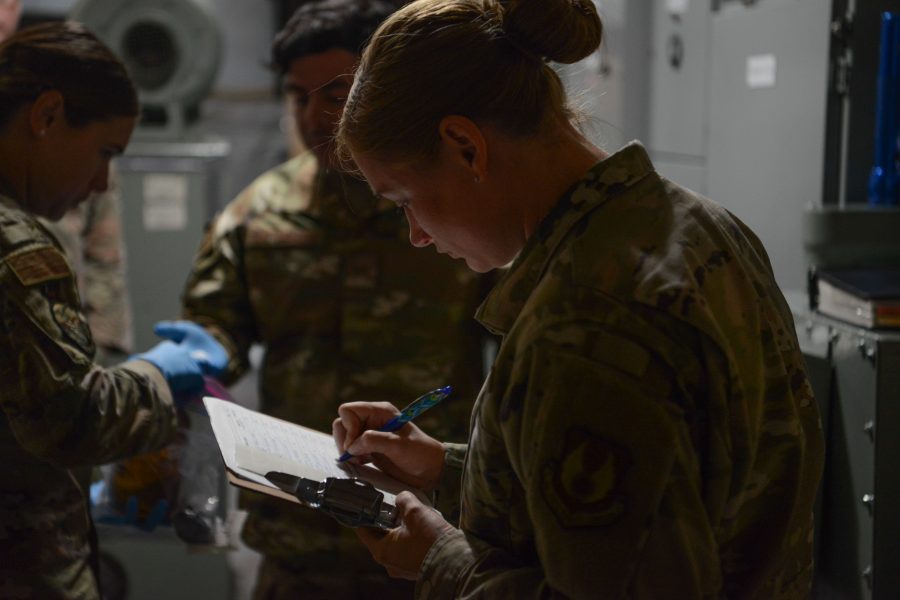The Air Force has found residue of a harmful and possibly carcinogenic substance at intercontinental ballistic missile facilities at Minot Air Force Base, N.D., it announced Aug. 24.
According to service officials, military bioenvironmental experts found elevated levels of polychlorinated biphenyls (PCBs) in an underground launch support building at the base.
The Air Force has now released findings on PCB levels at all three of its ICBM bases. Two—Minot and Malmstrom Air Force Base, Mont.—had levels that exceeded the Environmental Protection Agency’s acceptable limit, while the third, F.E. Warren Air Force Base, Wyo., had trace amounts of PCBs below the EPA’s acceptable limit.
Air Force Global Strike Command has ordered clean-ups for all three bases.
“Based on these survey results, I directed Twentieth Air Force to take immediate measures to mitigate exposure by our Airmen in all locations where PCBs were detected,” AFGSC commander Gen. Thomas A. Bussiere said in a statement, referring to the Numbered Air Force that oversees ICBM bases.
The Air Force is conducting extensive environmental testing at its ICBM bases as part of the Missile Community Cancer Study, which has two parts: environmental sampling of Active bases and an epidemiologic study of personnel who served in ICBM fields to assess cancer rates.
One of the purposes of testing was to search for polychlorinated biphenyls (PCBs) in launch control centers, the underground bunkers where missileers work in 24-48 hour shifts, and in other facilities.
PCBs are “probable human carcinogens” according to the EPA, which adds that they “have been demonstrated to cause a variety of adverse health effects.”
The findings at Minot were outlined in an Aug. 21 memo from Col. Tory Woodard, the commander of the U.S. Air Force School of Aerospace Medicine (USAFSAM), which is leading the study on behalf of the service.
Three hundred total samples—air samples and swipe tests—were taken at Minot, with 30 returning traces of PCBs. The swipe tests involve gauze wetted with a solution run over surfaces and then analyzed for suspected contaminants. No air samples detected PCBs, Woodard’s memo states. Twenty-eight of the 30 samples that detected PCBs were below limits.
Two swipe samples, however, had levels above EPA limits—both in the same facility, a Launch Control Equipment Building (LCEB).
LCEBs sit alongside the underground Launch Control Centers (LCC) and provide mechanical support. Above-ground Missile Alert Facilities (MAFs) were also tested, but did not return traces of PCBs.
“We will begin immediately cleaning PCBs in all LCCs and LCEBs where PCBs were detected, regardless of whether they met EPA standards for mitigation,” Bussiere said of the Minot findings.
“Further rounds of testing for PCBs will take place in all these locations to help us measure the effectiveness of our mitigation efforts,” he added.
PCB production was banned in 1979, but the intercontinental ballistic missile facilities are decades old. An AFGSC official familiar with the study previously told Air & Space Forces Magazine the Air Force began phasing out PCBs at ICBM facilities in the 1980s, but the tests would ultimately determine how thoroughly that process was conducted.
Yet PCBs are far from the only—or main—concern of the ongoing Missile Community Cancer Study. There have long been concerns voiced by former missiles and other personnel stemming from their duties at ICBM bases. Those concerns were highlighted when a presentation detailing cases of non-Hodgkin lymphoma, a blood cancer, at Malmstrom appeared online earlier this year.
Bussiere ordered a review of the issue, which led to the study, overseen by USAFSAM. Members of the study team carried out initial visits in February and March at the ICBM bases to understand what they should look for and where—ICBM silos are spread out over vast fields that reach into five states, with underground and surface support facilities. Among the potential dangers, the study teams found stickers indicating the presence of PCBs in older electronics—one reason PCBs have been an early focus of the study.
“These results are just the first part of an extensive survey taking place at all our missile bases,” Bussiere said. “As more results come, we will provide updates to our Airmen and families, along with the resources they need to understand the results. My absolute priority is to provide Airmen with a safe and clean working environment, so they can carry out our nation’s most important missions.”
In particular, researchers are still looking awaiting results from ground and water sampling at all three ICBM bases.
“Additional results for other environmental samples collected will be reported separately, as these are still being analyzed and are not yet available,” Woodard wrote in his latest memo.
